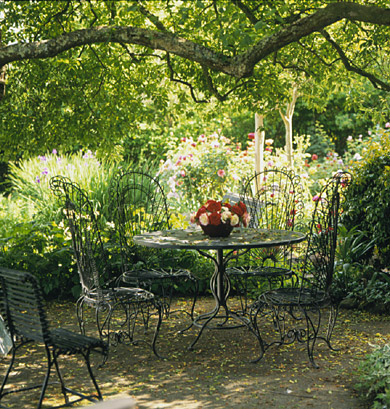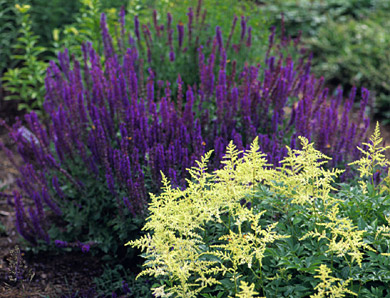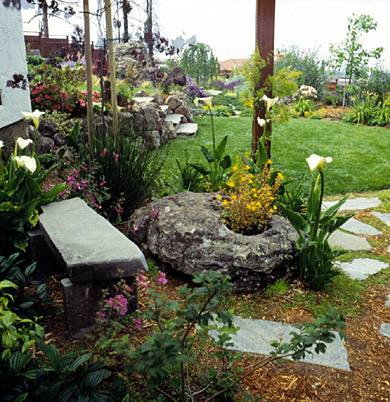





 Design a garden that you can enjoy and use for entertaining.
Design a garden that you can enjoy and use for entertaining.
1. Educate yourself. Spend those long winter evenings reading garden magazines and books and poring over catalogs. You'll slowly be able to determine the look you want and envision what plants will work in your garden.
2. Don't feel compelled to put it on paper. Sure, you can chart it all out, but nothing can predict the result precisely (not even those fancy professional landscape plans). Many a great garden has been created with absolutely no paper plans. Rely on your eye and the three-dimensional effect you see while working in your garden.
Design online with our Plan-a-Garden tool!
3. Designate areas for particular activities. Your yard will work better and more efficiently if you have spots designated for dining outdoors, the grill, the garbage cans, the swing set, and all those other things for which we use our landscapes.
Get even more DIY landscaping tips.
4. Remember, any spot can be a garden. No matter how shady or how baked, how flat or how steep your site is, a beautiful garden can flourish there. It simply takes planning a garden that is suited to the site, rather than fighting it. And no excuses about it being too small. Plant every inch with interesting plants.
Get tips for tricky spots with our Backyard Landscape Solutions guide.
5. Take photos. A photograph makes you look at your garden objectively and gives you the big picture. Scrawl in ideas with a permanent marker or grease pencil.
6. Write it down. When you see a plant you love, write down its full name in a garden journal or file. Keep track throughout the growing season of what is blooming when, so you can create a garden that blooms all season long.
7. Look at your garden during the winter. That's when its strengths and weaknesses are most apparent. Is the back of the neighbor's garage an eyesore? Could a path leading around the side of the house or to the garage make that space more usable and attractive?
continue reading below8. Don't plant in soldier-straight rows. Instead, plant in clumps of at least three for most perennials and clumps of at least one dozen for most annuals. For even more impact, plant in large drifts that might have 10 or more perennials and 40 or more annuals.
9. Mix it up. Who says the vegetables all have to go in the vegetable garden? Many are highly decorative and charming in the flower border. Dwarf fruit trees are great vertical accents in a perennial border. And why segregate the roses or herbs into cramped gardens of their own?
Learn more about edible landscaping.
10. Go for a variety of shapes. Put a tall, spiky plant next to a low, fluffy plant. Juxtapose large bold-shape flowers with small delicate blooms.
 Purple salvia adds maximum color impact.
Purple salvia adds maximum color impact.
11. Foliage is important. Go for contrast in color, texture, and shape of flowering plant foliage. Don't think of everything as plain green. Put the tall, emerald green, grasslike foliage of Siberian iris next to the low, chunky, silver-gray foliage of lamb's-ears, for example. Foliage also comes in yellow-greens, spring greens, blue-greens, and with variegations that include bits of white, red, purple, and other colors.
12. Come up with a color theme. As tempting as it is to choose a splash of this and a bit of that, the best gardens have a general color theme, such as pink with touches of blue, white, and yellow.
Master the art of using color in the garden.
13. Experiment. Sometimes seemingly unlikely combinations are stunning, like the vivid red tulips that bloom next to the deep purple tulips, or the silvery foliage that tones down an orange flower.
14. Choose a theme for your garden, and look to your house for inspiration. Do you have a Cape Cod that cries out for a cottage garden look? Or a Georgian-style home that's perfect for a formal garden? Or maybe a contemporary home with rough wood siding that is a natural for wildflowers?
15. Use garden accents sparingly. A birdhouse or two, a bench, and perhaps one very well-chosen statue are about as much as a small garden can withstand. Don't clutter the natural beauty of plants with too many outdoor knickknacks.
16. Fragrance is important. Plant with special attention to those plants that are intensely fragrant (lilacs, Oriental lilies, roses, and others). Even if the garden isn't looking perfect, it will smell that way.
Discover top fragrant flowers for your garden.
17. Go for regional flavor. Rely on plants native to your region and on garden accents that fit in with the locale. Midwestern gardens, for example, are perfect for prairie flowers with accents such as old wagon wheels, antique pumps converted into fountains, and weathered picket fences.
Learn more about gardening in your region.
18. Don't rule out a formal garden. Formal gardens tend to scare people who think they have to be stuffy and high-maintenance. But a formal garden with informal elements, such as a wood-chip path rather than brick and a low lavender hedge rather than clipped boxwood, can be casual and low-maintenance.
Get tips for designing with formal style.
19. Include an element of mystery. Create a path that winds out of sight even if it ends up nowhere. Plant large plants that block the view of at least a small part of the garden. Don't let your garden unveil itself in one sweeping view, and it will be more interesting.
 Decide how much structure you want for your garden.
Decide how much structure you want for your garden.
20. Nearly every garden needs a garden path. It directs people through the garden, making it a journey instead of a destination. Make it long and curving and at least 3 feet wide. It doesn't have to be fancy -- grass or wood chips will do.
Get inspiration from these garden paths.
21. Look up. A good garden has a variety of heights. Trees naturally provide a soaring vertical element, but nearly every garden benefits from trellises, arbors, bamboo tepees, or other structures that bring flowers up to eye level and prevent the garden from hugging the ground too tightly.
22. Don't be skimpy. If you're going to make a flower bed or border, make it big enough to include a variety of plants that will have interest in every season. Go for borders that are 6 or even 9 feet deep and three times that long. Scatter pavers or stepping-stones on the soil to give you a convenient place to stand while tending the garden.
23. Have at least one window box. Big on charm, small on price -- not to mention easy to care for -- window boxes add a new dimension to your garden and loads of character. If you already have window boxes, consider putting some on your second story. Very European.
Design amazing window boxes with our tips.
24. Recycle. Use found or leftover materials as garden inspirations. Leftover branches from a pruning project can be used as a tepee to support morning-glories. Old wood weathering behind the garage can be crafted into a rustic bench. Local fieldstone can be gathered and turned into a path.
Get more tips on using salvaged landscaping materials.
25. Don't try too much at first. A small garden that's well-tended is better and has more impact than a large garden that's out of control.
26. Prune wisely. Don't worry about pruning all your shrubs into tight little balls and boxes. Let them grow out for a softer, more natural look.
Check out our pruning guide!
27. Install edging of some sort in your flowerbed. Preferably, the edging should be of an attractive, natural material, such as wood, salvaged brick, or stone. It will keep out grass and weeds, and, even when your garden is a little messy, the edging will give it structure and make it seem a bit neater.
28. Find or create a vista. This doesn't have to be a sweeping view of a mountain range. Maybe you have a nice tree at the end of the yard. Make sure there's a clear sight line to it, and maybe play it up with a small statue or water feature beneath.
29. Create a background. This gives a garden a sense of enclosure and shows off flower beds and other plantings to their best advantage. The background can be a hedge, a nice fence (not chain-link), shrubs, or small trees.
30. Mask the uglies. If you have a chain-link fence or a falling-down garage, plant it with perennial vines, or front it with a hedge. Transform a dreary and cracked concrete patio by building up a low wood frame around it and covering it with gravel. Or cover it with a woven-grass mat and attractive outdoor furniture.
Copyright © www.100flowers.win Botanic Garden All Rights Reserved